 By: Rogerio Domenge
By: Rogerio Domenge
In recent decades, there has been a growing concern in the national and international business world over activities that may cause pollution, global warming, greenhouse gas emissions and exhaustion of renewable energy sources. These concerns have had an increasing impact on business strategies and models, incorporating new variables into their design or redesign (planning, mission, vision, values, organizational culture, sustainable development, etc.) and in their execution (quality systems, waste and emissions management, product and production technologies, recycling, facilities, logistics, energy generation and consumption, etc.), all according to the relatively new notion of the “sustainable company.” Many times, however, there is no clear idea of what “sustainability” means, its purposes, or the reasons for a company to adopt it.
Sustainability
The concept of sustainability has been defined by a number of organizations from perspectives that vary depending on the nature and goals of each. Perhaps the most important definition of sustainable development is that proposed by the Brundtland Commission, or World Commission on Environment and Development (WCED), formed by the United Nations in 1983 amid growing concerns over the deterioration of the environment and natural resources and their negative impact on the world’s economic and social development.
This commission’s goal was to establish sustainable development policies, on the assumption that these problems are global in nature, and therefore require a global perspective to diagnose and solve them. In 1987, the Brundtland Commission published its report, entitled Our Common Future (WCED, 1987). Among other points, the report asserts that sustainable development is the only way to satisfy current and future human needs without disrupting the balance of the planet, which includes all forms of life, natural resources, water, air, etc.
For the WCED, sustainable development has to do with social and economic advance that “meets the needs of the present”, ensuring a healthy and productive life for current generations, “without compromising the ability of future generations to meet their own needs.” This concept relates the activities of companies that produce goods and services for society to their tremendous responsibility as the largest user of natural resources, taking into account nature’s limited capacity to offset, balance or maintain its own natural state. A company identifies and defines the type of goods and services it will offer according to human needs, particularly basic needs. But the companies are also part of a social system in which there are factors that limit them, like the type of technology used in their processes, the social and cultural organization surrounding them, and the laws they must abide by.
From a broader perspective, it is possible to conceive of sustainability as the capacity of a dynamic system to reach a stable state by achieving a balance among the resources it uses and its environment, achieved through internal mechanisms of self-regulation, adaptation, flexibility, response capacity and resilience (Minolli, 2000). Sustainability can be said to exist when the measures or indicators of the system do not decline (Gallopín, 2003), or in other words, when they maintain or improve their performance and use up resources more slowly than those resources can renew themselves. In the systemic focus, this characteristic is also known as homeostasis (from the Greek word meaning “an equal or similar state or position than”). This concept is used in various types of system-biological, ecological, economic, social and cybernetic.
In 2002, the Johannesburg Declaration on Sustainable Development (JDSD) adopted a more general focus on sustainable development, envisioning a model with three basic pillars (economic, social and environmental, or triple outcome) which has since then been broadly accepted and used (Kates et al., 2005). This model proposes to build and strengthen these three pillars to achieve sustainable local, national, regional and global development. The three pillars refer to the following factors:
Economic development. This concerns economic growth and the pursuit of well-being. It incorporates industries and productive sectors that provide jobs and all the aspects of an economy: markets, consumption, competition, efficiency, productivity, technology, innovation, and research and development.
Social development. This includes the cultural, legal and political climate as expressed in beliefs, traditions, customs, habits, lifestyles, education, values, goals, institutions, laws and regulations, all of it directed at maintaining a stable state (homeostasis), but leaving room for changes, renewal and adaptations which many times are introduced amid disputes and objections. Sustainability is, among other things, the result of the application of or conformity to a system of social norms, which is in turn dynamic because it gradually incorporates modifications for the purpose of self conservation and development.
Environmental protection. This pillar refers to the rational use of scarce natural resources. Sustainability is achieved when the company does not exploit one or more resources beyond its capacity to renew itself, which would lead to an imbalance or deterioration of the environment, and therefore, the company itself.
If the company and its environment are considered the focal system, this system’s sustainability can be understood as the capacity and potential to maintain a healthy and productive balance, meeting the needs and favoring the well-being of the population through the supply of goods and services, without exploiting (by technology) natural resources (energy, forests, water systems, etc.) beyond their capacity or speed of renewal, and within the institutional (regulatory) framework of the social environment (Figure 1).

Figure 1. Company and environment as focal system
Companies today face sustainability issues that were not present in the past. If a company intends to be sustainable, its management must explicitly include new elements in its strategic planning–responsible forms of engineering and exploitation of natural resources, and new investments in technological development that take into account their impact on the energy supply and their production of contaminants–to keep up with the rapid changes in the institutions around it. Ideally, these elements should be consistent with the current and future needs of the population.
At the same time, we might ask what is it that really prompts a modern company to adopt a system of sustainable management. What or who are the drivers or catalysts of this process?
Three triggers
Figure 1 shows the agents of the activities that influence sustainability: the population, or private and public consumers of goods and services, which show a growing trend to consume more responsibly, influencing the management and performance of the company; the companies that produce the goods and services, through their environmental management; committed employees and workers, who are increasingly trained and aware of their responsibilities toward the environment; visionary investors, whose decisions now take into account the performance and sustainability of their projects; regulatory entities, both formal and informal, in the social environment, which compel companies and the population in an increasingly decisive (mandatory) fashion to adopt the path of sustainability through policies, laws, standards, etc.; and other profit and nonprofit organizations, like academe, the media, and the voluntary sector. The following are three of the primary triggers for this process.
Obligation
This is the legal aspect. One of the fundamental elements in the issue of sustainability, companies and the social environment (figure 1) is the regulatory entity in charge of designing environmental legislation (in Mexico, the General Law on Ecological Balance and Environmental Protection), based on an ideal vision of the overall system and its development policies. This entity must balance the interests of society, the natural needs of the environment and the economic health of companies in developing government policies that take the form of laws, standards, taxes, fines, subsidies, incentives, and information programs (for example, the Mexican Ministry of the Environment and Natural Resources).
Conviction
This is the ethical aspect. The ethical company that generates economic and social value has a vision that is not confined to a simple short-term return on investment, which many more nearsighted companies adopt. It incorporates the aspects of an ethical and social responsibility for service that incorporates all stakeholders–society, clients, shareholders, employees, suppliers, lenders and the government. It arises from the profound convictions of the company’s directors, and is expressed in a number of actions, like behavior and respect for codes of ethics that incorporate the best business practices and standards, transparent action and reporting, anti-corruption measures, supervision of compliance with official rules and procedures, and investment in research and development to develop explicit sustainable practices for respecting, preserving, or improving the environment. The company generates social value because, among other actions, it trains and educates its members in an organizational culture with its own identity, objectives and values, and it sows the seeds of many social behaviors, institutions, values, attitudes and actions.
Good for business
“Good” in this case means profitable. Ideas differ with regard to the benefits or disadvantages of being a sustainable company from the standpoint of economic profitability. Sustainability can be perceived as an expense that brings no economic return, as an investment decision in traditional cost-benefit terms, with its corresponding return and risk, or as a strategic path and investment, as is summed up in Porter’s hypothesis (1995 and 2006), under which stricter environmental legislation not only lessens environmental damage but also leads to the development of better technological innovation and reduces production costs, while improving product quality. Porter considers sustainability to be a means of survival for the company in a dynamic, global and aggressive climate, in which it must adapt to new needs and demands of consumers in order to improve its competitive position.
In MIT’s global survey (2009, www.sloanreview.mit.edu) on sustainability and business, applied to company executives, there was a general consensus that sustainability heavily influences business decisions. And although 92% of companies take sustainability into account when deciding, most of them do not do everything they could to seize the opportunities it may offer. Thus, 70% have not drawn up a business plan that includes sustainability aspects. The companies that initiate vigorous sustainability actions discover an increasing number of opportunities.
In the corporate environmental survey by BDO Kendalls (2009) the triggers of sustainability are ordered as follows: economic, social and environmental. Another example is published by Siemens (2011, www.usmayors.org), reporting on a survey on sustainability among a sampling of US city governments, finding that the expected economic benefits are the primary trigger for cities to design strategies to develop new clean technologies. The survey discovered that one out of every three US cities has already budgeted for investments in adaptation to climate change.
According to Loch (2010) there is a great deal of proof of the business value to be generated in following the path of sustainability, but the strategies to achieve it must be defined and more clearly communicated to consumers, employees and investors. Loch’s study was based on the results of the survey applied to a sampling of 304 executives from a list of Fortune’s 1000 top companies, and another of 2600 American consumers over the age of 18. Loch recognizes that there is still a certain amount of skepticism-only 29% of executives and 16% of customers believe the companies are highly committed to sustainability, and 88% believe the companies should assume a moral responsibility to sustainability independent of regulatory requirements. Among the reasons for this skepticism is the low level of return on investment (78%) in sustainability projects, and the difficulty of measuring and evaluating sustainability (41%). On the consumer side, 71% are not willing to pay more for goods and services with sustainable characteristics. Among the executives, 61% believe that the main motive for a company to incorporate sustainability would be cost reduction.
Some indicators in Mexico also reveal a trend toward sustainability. For example, in a multinational survey on attitudes about global warming published by the World Bank (2010), related with results of the COP-15 Conference in Copenhagen and carried out by PricewaterhouseCoopers (PwC), 93% of respondents for Mexico said they agreed that their country should commit to sustainability, understanding that it would involve certain costs, in order to reduce greenhouse gases, because 94% of them believe that they affect human health. These are the highest figures in the world! In the PwC 2010 report entitled Sustainability Reporting in Mexico, it analyzed 38 reports from Mexico’s top companies, looking specifically for indicators of their performance in the three-pillar model. It found growing pressure to be more transparent in communicating the company’s social responsibility values, principles and results, among others. It concluded that these reports help improve risk management and valuation, because they allow companies to identify strategic opportunities that can be economically, environmentally and socially profitable. Among the issues most discussed by companies in referring to their sustainability activities are energy, water, solid waste and atmospheric emissions. Leaks and spills, environmental fines, the environmental impact of transportation, and environmental investment are among those least mentioned.
Conclusions
Conceiving of the focal system as a whole, including all the elements shown in Figure 1, and not just as a system of company-environment, can help us to define the actions and responsibilities of each participant, in turn making it easier for company to take on the dynamics of sustainability. Sustainability incorporates practically all human activities, and companies are a link that can contribute greatly to achieving this. The elements of the system are the social climate and its institutions, which orient the system toward sustainability through policies that coherent with the current and future needs of the population (together with their awareness and education), the environment and its limited resources, and the company with its sustainable management.
Entrepreneurs increasingly agree that business decisions and investment in sustainability will be a fundamental factor in corporate strategies in coming years. Sustainability opens new business opportunities and may even be the seed for the development (not just economic growth) of new industries with new technologies, such as renewable energy. A review of the secondary sources cited in this article tell us that the primary trigger for companies’ efforts to adopt sustainability are economic benefits, profitability, cost reduction, risk mitigation, and brand image, followed by the regulatory framework and the ethical aspect. Ultimately, however, sustainability is an effort to conserve the natural world, balancing business decisions with environmental and social criteria to create value not just for the company but for society as a whole.?
References
- World Bank. (2010). Climate change poll, http://blogs.worldbank.org/climatechange/category/tags/poll,
- BDO Kendalls (2009). Corporate and environmental sustainability survey, www.scribd.com/doc/23356084/2009-Corporate-and-Environmental-Sustainability-Survey.
- Gallopín, G. (2003). A systems approach to sustainability and sustainable development.
- CEPAL, UN: Sustainable Development and Human Settlements Division.
- JDSD (2002). The Johannesburg Declaration on Sustainable Development, www.housing.gov.za/content/legislation_policies/johannesburg.htm.
- Kates, R.W., Parris, T.M. y Leiserowitz, A.A. (2005). What Is Sustainable Development? Goals, Indicators, Values, and Practice. Environment. 47(3): 9-21.
- Federal Government of Mexico. Ley General del Equilibrio Ecológico y la Protección al Ambiente. Diario Oficial de la Federación, 28 January 1988.
- Loch, R. (2010). Gibbs and Soell Sense and Sustainability Study, www.gibbs-soell.com.
- Massachusetts Institute of Technology (2009), www.sloanreview.mit.edu,Minolli, C. B. (2000). Empresas resilientes. Buenos Aires: UCEMA.
- Porter, E.M. y Kramer, M.R. (2006, diciembre). Strategy and Society. HBR.
- Porter, M.E. y Van der Linde, C.(1995). Towards a new conception of the environment: Competitiveness relationship. Journal of Economic Perspectives. 9(4).PwC (2010), Sustainability Reporting in Mexico, www.scribd.com/doc/38689573/.
- Secretaría del Medio Ambiente y Recursos Naturales. Liderazgo ambiental para la competitividad, www.semarnat.gob.mx/liderazgo/Paginas/liderazgo.aspx.Siemens (2011), www.usmayors.org
- World Commission on Environment and Development (1987). Our Common Future. Oxford: Oxford University Press.


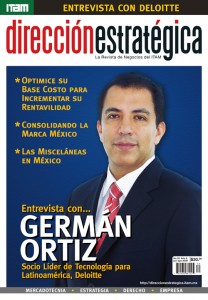

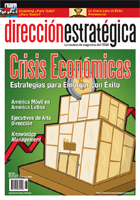



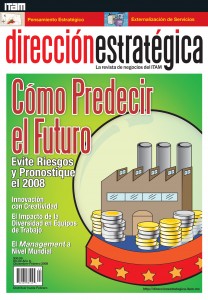



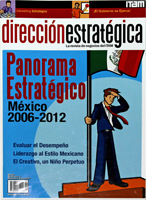


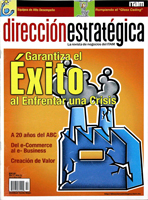


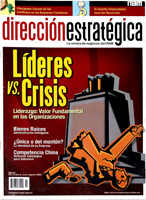













One Comment
Personalmente, estoy convencido que no es mas una opción. Las Empresas no tienen futuro sin Sustentabilidad. El desafío es hacer converger la eficiencia con la eficacia, y hacer económicamente atractivo lo ambientalmente amigable.